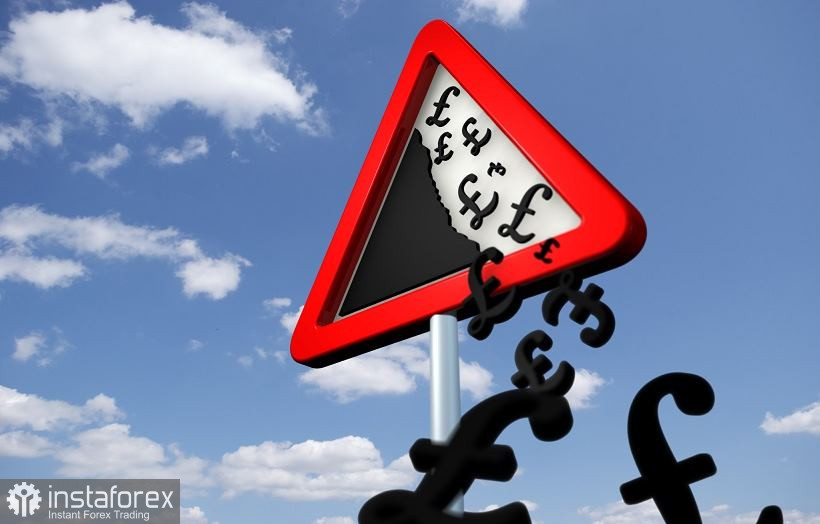The pound-dollar pair is plunging, following the US currency, which is gaining momentum throughout the market. The prevailing fundamental background allows dollar bulls to dominate all currency pairs of the major group. The growth of anti-risk sentiment and hawkish signals from the Federal Reserve are the two pillars on which the US dollar is held. The pound, in turn, demonstrates a passive position, despite the record increase in British inflation, which was recorded in July. Apparently, traders are concerned about the risks of stagflation, given the latest data on GDP growth in the UK amid earlier pessimistic forecasts of the Bank of England regarding the growth of the national economy in the second half of this year and in 2023.

And yet the greenback plays the role of the first violin in the weakening of the GBP/USD pair. More recently, dollar bulls were under pressure from inflation releases, which reflected the first signs of a slowdown in inflation in the United States. The most important inflation reports (consumer price index, producer price index) came out in the red zone, questioning the expediency of aggressive actions to tighten the Fed's monetary policy. The probability of a 75-point rate hike at the September meeting has significantly decreased: the majority of economists polled by Reuters said that the central bank is likely to increase the rate by 50 points and will continue to adhere to a moderate pace of rate hikes.
But the first (after the release of the latest inflation reports) comments from the Fed representatives suggested that it was too early to discount the option of a 75-point hike. For example, the head of the St. Louis Fed, James Bullard, who has the right to vote in the Committee this year, recently announced that he would support a 75 basis point rate hike at the September meeting. In his opinion, there is a high level of inflation in the country, so he is ready to vote in favor of a more hawkish decision.
His colleague, the head of the Federal Reserve Bank of Kansas City, Esther George (who, by the way, also has the right to vote this year), also did not rule out the implementation of the most hawkish scenario in September. And although George did not directly declare support for a 75-point increase, she did not focus on slowing CPI growth. According to her, the Fed will continue to discuss at what pace the rate will increase in the future, "although its direction is quite clear."
Another representative of the Fed (also with voting rights), Michelle Bowman, announced last week that the central bank would maintain a hawkish course and raise the interest rate by 50 or 75 points in September.
A similar position was voiced by Thomas Barkin and Mary Daly.
In other words, representatives of the Fed (at least from among those who voiced their position) maintained a hawkish attitude, despite the first signs of a slowdown in the consumer price index in the United States. Therefore, the issue of a 75-point rate increase at the next meeting returned to the agenda. We can say that now this option is in balance with the 50-point option on a kind of scale. By the way, the CME FedWatch data even tip the scales towards a more hawkish decision: the futures segment with a probability of 54% suggests an increase in the rate by 75 basis points. There is a 46 percent probability, respectively, in favor of a 50-point rate increase.
This fundamental factor allowed dollar bulls to strengthen their positions throughout the market, including in pairs with the pound. In addition, the safe dollar is in high demand amid the worsening energy crisis and ongoing geopolitical tensions.
The pound, in turn, is under pressure, despite a record rise in inflation and hawkish signals from some representatives of the BoE. However, according to many analysts, the British central bank will have to reckon with the threat of recession when making the next decision on monetary policy.

Let me remind you that following the results of the August meeting, the BoE announced disappointing macroeconomic forecasts – in particular, the central bank predicted a recession of the British economy from the fourth quarter of this year. But inflation, on the contrary, is likely to be significantly ahead of the May forecast.
The macroeconomic reports that were published after this meeting confirmed the concerns of the members of the British central bank. For example, the general consumer price index reached double digits for the first time since February 1982, marking 10.1% in annual terms. The volume of UK GDP in the second quarter increased by only 2.9% (for comparison, it can be noted that an increase of 8.7% was recorded in the first quarter). On a quarterly basis, the indicator fell into the negative area, to the level of -0.1%. If we talk about monthly growth, then in June the British economy shrank by 0.6% on a monthly basis and by 0.1% on a quarterly basis.
Thus, the prevailing fundamental background allows the GBP/USD bears to dictate their conditions for the pair.
The priority of short positions on the GBP/USD pair is also indicated by the technical picture. In particular, the price on all higher timeframes is located either on the lower or between the middle and lower lines of the Bollinger Bands indicator, which is located in the extended channel. Trend indicators are confirmed by the MACD oscillator, which is in the overbought area. The support level (the target of the downward movement) is the lower line of the Bollinger Bands indicator on the weekly chart, which corresponds to the price of 1.1700. In this price area, it would be advisable to lock in profits and take a wait-and-see position.
 English
English 
 Русский
Русский Bahasa Indonesia
Bahasa Indonesia Bahasa Malay
Bahasa Malay ไทย
ไทย Español
Español Deutsch
Deutsch Български
Български Français
Français Tiếng Việt
Tiếng Việt 中文
中文 বাংলা
বাংলা हिन्दी
हिन्दी Čeština
Čeština Українська
Українська Română
Română

